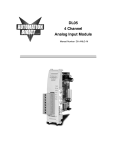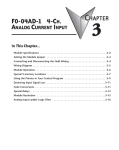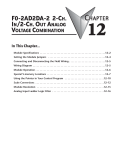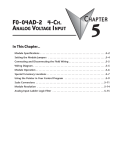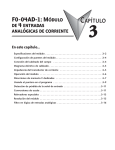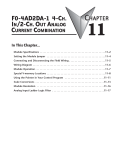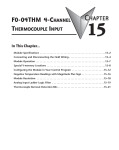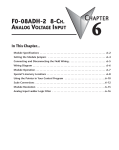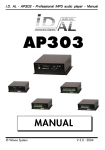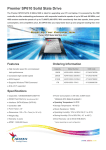Download F0-04AD-1 4-Channel Analog Current Input
Transcript
F0-04AD-1 4-Channel Analog Current Input 10 In This Chapter. . . . — Module Specifications — Setting the Module Jumper — Connecting and Disconnecting the Field Wiring — Wiring Diagram — Module Operation — Special V-memory Locations — Using the Pointer in Your Control Program — Detecting Input Signal Loss — Scale Conversions — Special Relays 10--2 F0-04AD-1 4-Channel Analog Current Input Analog Module F2--04AD--1, (L) 4-Ch. Current Input Module Specifications The F0-04AD-1 Analog Input module offers the following features: S The DL05 reads all four channels in one scan. S The removable terminal block makes it possible to remove the module without disconnecting the field wiring. S Analog inputs can be used as process variables for the (4) PID loops included in the DL05 CPU. S Field device burn--out is detected on all four channels when 4--20mA range is selected. S On-board active analog filtering and RISC-like microcontroller provide digital signal processing to maintain precise analog measurements in noisy environments. NOTE: The DL05 CPU’s analog feature requires DirectSOFT32 Version 3.0c (or later) and firmware version 2.1 (or later). See our website for more information: www.automationdirect.com. F0-04AD-1 4-Channel Analog Current Input 10--3 The following tables provide the specifications for the F0--04AD--1 Analog Input Module. Review these specifications to make sure the module meets your application requirements. Input Specifications 4, single ended (one common) Input Range 0 to 20 mA or 4 to 20 mA current (jumper selectable) Resolution 12 bit (1 in 4096) for 0--20mA, scaled for 4--20mA Step Response 25.0 mS (typ) to 95% of full step change Crosstalk --80 dB, 1/2 count maximum * Active Low-pass Filtering --3 dB at 40Hz (--12 dB per octave) Input Impedance 125 Ohm ±0.1%, !/8 W current input Absolute Maximum Ratings --30 mA to +30 mA, current input Converter type Successive approximation Linearity Error (End to End) ±1 count (0.025% of full scale) maximum * Input Stability ±1 count * Full Scale Calibration Error (Offset error not included) ±10 counts maximum, @ 20mA current input * Offset Calibration Error ±5 counts maximum, @ 4mA current input * Maximum Inaccuracy ±.4% @ 25°C (77°F) ±.85% 0 to 60_C 60 C (32 to 140 140°F) F) Accuracy vs. Temperature ±80 ppm/_C maximum full scale calibration (including maximum offset change) Recommended Fuse (external) 0.032 A, Series 217 fast-acting, current inputs F2--04AD--1, (L) 4-Ch. Current Input Number of Channels * One count in the specification table is equal to one least significant bit of the analog data value (1 in 4096). General Specifications PLC Update Rate 4 channels per scan 16--bit Data Word 12 binary data bits, 2 channel ID bits, 2 diagnostic bits Operating Temperature 0 to 60_ C (32 to 140° F) Storage Temperature -20 to 70_ C (-4 to 158° F) Relative Humidity 5 to 95% (non-condensing) Environmental air No corrosive gases permitted Vibration MIL STD 810C 514.2 Shock MIL STD 810C 516.2 Noise Immunity NEMA ICS3--304 Analog Module 10--4 F0-04AD-1 4-Channel Analog Current Input Setting the Module Jumper The default jumper setting selects a 4--20mA signal source. The default jumper setting does not connect the two pins. OFF = 4 -- 20 F2--04AD--1, (L) 4-Ch. Current Input The position of jumper J3 determines the input signal level. You can choose between 4--20mA and 0--20mA. The module ships with the jumper not connecting the two pins. In this position, the expected input signal is 4--20mA. To select 0--20mA signals, use the jumper to cover both pins. J3 WARNING: Before removing the analog module or the terminal block on the face of the module, disconnect power to the PLC and all field devices. Failure to disconnect power can result in damage to the PLC and/or field devices. Connecting and Disconnecting the Field Wiring Analog Module Wiring Guidelines Your company may have guidelines for wiring and cable installation. If so, you should check those before you begin the installation. Here are some general things to consider: S Use the shortest wiring route whenever possible. S Use shielded wiring and ground the shield at the transmitter source. Do not ground the shield at both the module and the source. S Do not run the signal wiring next to large motors, high current switches, or transformers. This may cause noise problems. S Route the wiring through an approved cable housing to minimize the risk of accidental damage. Check local and national codes to choose the correct method for your application. The F0--04AD--1 does not supply power to field devices. You will need to power transmitters separately from the PLC. To remove the terminal block, disconnect power to the PLC and the field devices. Pull the terminal block firmly until the connector separates from the module. You can remove the analog module from the PLC by folding out the retaining tabs at the top and bottom of the module. As the retaining tabs pivot upward and outward, the module’s connector is lifted out of the DL05 socket. Once the connector is free, you can lift the module out of its slot. 10--5 F0-04AD-1 4-Channel Analog Current Input Wiring Diagram Use the following diagram to connect the field wiring. If necessary, the F0--04AD--1 terminal block can be removed to make removal of the module possible without disturbing field wiring. + -- Typical User Wiring Internal Module Wiring + + CH1+ -- + -- CH2-- + 125 ohms CH3+ -- + 1 -+ 2 -- A to D Converter + 3 -+ 4 -- 125 ohms + + CH4 2-wire -4--20mA Transmitter CH3-- Analog Switch CH2+ + CH3 2-wire 4--20mA -Transmitter CPU T X1 R X1 T X2 RX2 CH4+ -- NOTE 1: Shields should be grounded at the signal source. NOTE 2: Connect all external power supply commons. NOTE 3: A Series 217, 0.032A fast--acting fuse is recommended for current loops. Current Loop Transmitter Impedance RUN 125 ohms + + CH2 3--wire -4--20mA Transmitter PWR CH1-- F2--04AD--1, (L) 4-Ch. Current Input CH1 4--wire -4--20mA Transmitter A n a lo g In pu t 4 -- CH A N N EL S 0 -- 20 m A 4 -- 20 m A -+ -+ -+ -+ CH4 CH3 CH2 CH1 See NOTE 1 CH4-- F0 - 04 AD - 1 125 ohms -- + 18-30VDC Supply OV Transmitter Supply Manufacturers of transmitters and transducers specify a wide variety of power sources for their products. Follow the manufacturer’s recommendations. In some cases, manufacturers specify a minimum loop or load resistance that must be used with the transmitter. The F0-04AD-1 provides 125 ohm resistance for each channel. If your transmitter requires a load resistance below 125 ohms, you do not have to make any changes. However, if your transmitter requires a load resistance higher than 125 ohms, you need to add a resistor in series with the module. Consider the following example for a transmitter being operated from a 30 VDC supply with a recommended load resistance of 750 ohms. Since the module has a 125 ohm resistor, you need to add an additional resistor. R = Tr - Mr R = 750 - 125 R = 625 R = resistor to add Tr = Transmitter Requirement Mr = Module resistance (internal 125 ohms) DC Supply +30V 0V Module Channel 1 R CH1+ CH1-125 ohms 0V Analog Module Two-wire Transmitter + -- 10--6 F0-04AD-1 4-Channel Analog Current Input Module Operation F2--04AD--1, (L) 4-Ch. Current Input Channel The DL05 reads all four channels of input data during each scan. The CPU supports special V-memory locations that are used to manage the data transfer. This is Scanning Sequence with a discussed in more detail in the section on Writing the Control Program. DL05 Scan DL05 PLC Read Inputs Execute Application Program Read the data Store data Scan N Ch 1, 2, 3, 4 Scan N+1 Ch 1, 2, 3, 4 Scan N+2 Ch 1, 2, 3, 4 Scan N+3 Ch 1, 2, 3, 4 Scan N+4 Ch 1, 2, 3, 4 Write to Outputs Analog Module Analog Module Updates Even though the channel updates to the CPU are synchronous with the CPU scan, the module asynchronously monitors the analog transmitter signals and converts each signal into a 12-bit binary representation. This enables the module to continuously provide accurate measurements without slowing down the discrete control logic in the RLL program. The module takes approximately 25 milliseconds to sense 95% of the change in the analog signal. For the vast majority of applications, the process changes are much slower than these updates. NOTE: If you are comparing other manufacturers’ update times (step responses) with ours, please be aware that some manufacturers refer to the time it takes to convert the analog signal to a digital value. Our analog to digital conversion takes only a few microseconds. It is the settling time of the filter that is critical in determining the full “update time.” Our update time specification includes the filter settling time. F0-04AD-1 4-Channel Analog Current Input 10--7 Special V-memory Locations Data Formatting The DL05 series has two special V-memory locations assigned to the analog input module. These V-memory locations allow you to: S specify the data format (binary or BCD) S specify the number of channels to scan (4 channels for the F0--04AD--1) S specify the V-memory locations to store the input data Analog Input Module V-memory Locations Data Type and Number of Channels V7700 Storage Pointer V7701 Structure of V7700 The DL05 PLC allows the use of bits 8 -- 15 for identifying the number of input channels and the data type (binary or BCD). The F0-04AD-1 module actually uses only bits 10 and 15, as shown in the diagram below. Bit 10 identifies the module as a 4 channel analog input module. This bit should be set to 1 for the F0-04AD-1 module. Bit 15 is used to distinguish BCD (= 0) and binary (= 1). Loading a constant of 0400h into V7700 puts a “1” in bit 10. This identifies a 4 channel analog input module in the DL05 option slot, and stores the input data values as BCD numbers. MSB Loading a constant of 8400h into V7700 puts a “1” in bit 15 and bit 10. This identifies a 4 channel analog input module in the DL05 option slot, and stores the input values as binary numbers. MSB F2--04AD--1, (L) 4-Ch. Current Input The table below shows the special V-memory locations used by the DL05 PLC for analog input modules. LSB 1 1 1 1 1 19 8 7 6 5 4 3 2 1 0 54 3 2 1 0 LSB 1 1 1 1 1 19 8 7 6 5 4 3 2 1 0 54 3 2 1 0 You will find an example program that loads appropriate values to V7700 and V7701 on page 10--9. Analog Module Structure of V7701 The DL05 PLC uses V7701 as a pointer to a V-memory location used for storing analog input data. The value loaded in V7701 is an octal number identifying the first word in a contiguous range of V-memory locations. For the F0-04AD-1 module, you will identify the first of four V-memory locations since it is a 4 channel module. For example, loading O2000 causes the pointer to write channel 1’s data value to V2000, channel 2’s data value to V2001, channel 3’s data value to V2002, and channel 4’s data value to V2003. 10--8 F0-04AD-1 4-Channel Analog Current Input Analog Module F2--04AD--1, (L) 4-Ch. Current Input Analog Data Bits Module Resolution The first twelve bits represent the analog data in binary format. Bit Value Bit Value 0 1 6 64 1 2 7 128 2 4 8 256 3 8 9 512 4 16 10 1024 5 32 11 2048 Since the module has 12-bit resolution, the analog signal is converted into 4096 counts ranging from 0 -- 4095 (212). For example, a 4mA signal would be 0 and a 20mA signal would be 4095. This is equivalent to a binary value of 0000 0000 0000 to 1111 1111 1111, or 000 to FFF hexadecimal. The diagram to the right shows how this relates to the signal range. Each count can also be expressed in terms of the signal level by using the equation shown. MSB LSB 4 -- 20mA 20mA 4mA 0 4095 Resolution = H - L 4095 H = high limit of the signal range L = low limit of the signal range 16mA / 4095 = 3.907µA per count F0-04AD-1 4-Channel Analog Current Input 10--9 Using the Pointer in Your Control Program Using the program below, the CPU examines the pointer values (the beginning memory location identified in V7701) on the first scan only. The example program below shows how to setup these locations. Place this rung anywhere in the ladder program or in the initial stage if you are using stage programming instructions. SP0 LD K 04 00 - or - LD K 84 00 Loads a constant that specifies the number of channels to scan and the data format. The upper byte selects the data format (i.e. 0=BCD, 8=Binary) and the number of channels (set to 4 for the F0--01AD--1). F2--04AD--1, (L) 4-Ch. Current Input This is all that is required to read the analog input data into V-memory locations. Once the data is in V-memory you can perform math on the data, compare the data against preset values, and so forth. V2000 is used in the example but you can use any user V-memory location. The binary format is used for displaying data on some operator interfaces. The DL05 PLCs support binary math functions. OUT V7700 LDA O2000 OUT V7701 Special V-memory location assigned to the expansion slot contains the data format and the number of channels to scan. This loads an octal value for the first V-memory location that will be used to store the incoming data. For example, the O2000 entered here would designate the following addresses. Ch1 -- V2000, Ch2 -- V2001, Ch3 -- V2002, Ch 4 -- V2003 The octal address (O2000) is stored here. V7701 is assigned to the expansion slot and acts as a pointer, which means the CPU will use the octal value in this location to determine exactly where to store the incoming data. Analog Module 10--10 F0-04AD-1 4-Channel Analog Current Input Detecting Input Signal Loss Analog Signal Loss The F0--04AD--1 analog module can sense the loss of analog input signals in 4--20mA loops. The Special Relays described on page 10--12 allow you to use this feature in your ladder program. For example, in the rung below SP610 is used to pull-in coil Y1, which would be used to open or close an external circuit. SP610 The Special Relay SP610 detects a loss of input signal to channel 1. Use SP610 to trigger an alarm or shut down a machine. Y1 F2--04AD--1, (L) 4-Ch. Current Input OUT NOTE: The F0--04AD--1 analog module cannot sense the loss of analog input signals in 0--20mA loops. See page for information about setting the jumper to select your input type. Scale Conversions Scaling the Input Data Many applications call for measurements in engineering units, which can be more meaningful than raw data. Convert to engineering units using the formula shown to the right. You may have to make adjustments to the formula depending on the scale you choose for the engineering units. Units = A H - L 4095 H = High limit of the engineering unit range L = Low limit of the engineering unit range A = Analog value (0 -- 4095) For example, if you wanted to measure pressure (PSI) from 0.0 to 99.9 then you would have to multiply the analog value by 10 in order to imply a decimal place when you view the value with the programming software or a handheld programmer. Notice how the calculations differ when you use the multiplier. Analog Module Analog Value of 2024, slightly less than half scale, should yield 49.4 PSI Example without multiplier Example with multiplier Units = A H - L 4095 Units = 10 A H - L 4095 Units = 2024 100 - 0 4095 Units = 20240 100 - 0 4095 Units = 49 Units = 494 Handheld Display V 2001 V 2000 0000 0049 Handheld Display V 2001 V 2000 0000 0494 This value is more accurate 10--11 F0-04AD-1 4-Channel Analog Current Input The Conversion Program The following example shows how you would write the program to perform the engineering unit conversion. This example assumes you have BCD data loaded into the appropriate V-memory locations using instructions that apply for the model of CPU you are using. Note: this example uses SP1, which is always on. You could also use an X, C, etc. permissive contact. SP1 When SP1 is on, load channel 1 data to the accumulator. MUL K1000 Multiply the accumulator by 1000 (to start the conversion). DIV K4095 Divide the accumulator by 4095. OUT V2010 Analog and Digital Value Conversions F2--04AD--1, (L) 4-Ch. Current Input LD V2000 Store the result in V2010. Sometimes it is useful to convert between the signal levels and the digital values. This is especially helpful during machine startup or troubleshooting. The following table provides formulas to make this conversion easier. Range If you know the digital value... If you know the analog signal level... 4 to 20mA A = 16D + 4 4095 D = 4095 (A - 4) 16 0 to 20mA A = 20D 4095 D = 4095 20 For example, if you have measured the signal as 10mA, you can use the formula to determine the digital value that will be stored in the V-memory location that contains the data. D = 4095 (A - 4) 16 4095 D= (10mA – 4) 16 D = (255.93) (6) D = 1536 Analog Module 10--12 F0-04AD-1 4-Channel Analog Current Input Special Relays Analog Module F2--04AD--1, (L) 4-Ch. Current Input The list of other Special Relays associated with the DL05 PLC is contained in the DL05 User Manual. The following special relays are new and relate to the status of the F0--04AD--1 module or one of its input channels. SP600 Chan 1 input type 0 = 0 -- 20mA 1 = 4 -- 20mA SP601 Chan 2 input type 0 = 0 -- 20mA 1 = 4 -- 20mA SP602 Chan 3 input type 0 = 0 -- 20mA 1 = 4 -- 20mA SP603 Chan 4 input type 0 = 0 -- 20mA 1 = 4 -- 20mA SP610 Chan 1 input open 0 = xmitter signal open 1 = xmitter signal good SP611 Chan 2 input open 0 = xmitter signal open 1 = xmitter signal good SP612 Chan 3 input open 0 = xmitter signal open 1 = xmitter signal good SP613 Chan 4 input open 0 = xmitter signal open 1 = xmitter signal good












